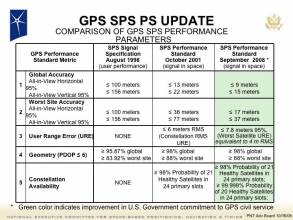
European Union (EU) member countries are close to adopting a standard for satellite navigation receivers.
The proposed standard covers Satellite Earth Stations and Systems (SESS) as well as GNSS receivers operating in the bands 1164 MHz to 1300 MHz and 1559 MHz to 1610 MHz. Receivers must be able to withstand interference from adjacent bands at the listed levels.
European Union (EU) member countries are close to adopting a standard for satellite navigation receivers.
The proposed standard covers Satellite Earth Stations and Systems (SESS) as well as GNSS receivers operating in the bands 1164 MHz to 1300 MHz and 1559 MHz to 1610 MHz. Receivers must be able to withstand interference from adjacent bands at the listed levels.
A draft of the standard — specifically standard number ETSI EN 303 413, which was developed by the Telecommunications Standards Institute (ETSI) — has been released for a period of combined public inquiry and voting. It was not clear at press time where the voting process stood.
"If this thing goes into effect, with the force of law, basically what they’re saying is that you need to be able to accept the following levels of interference into your GNSS receiver and suffer no more than 1 dB of degradation (in the carrier-to-noise-density ratio or C/N0)," said Logan Scott, a Colorado-based expert on radio frequency signal processing and waveform design for communications, navigation, radar and emitter location. "So it is a standard."
The draft specifies, for example, that receivers must be able to handle interference levels of -95 decibel/milliwatt (dBm) from the 1525 MHz to 1549 MHz band with no more than 1 dB degradation in the signal to noise ratio in GNSS receivers.
See TABLE 4-2 above. The document notes that it "does not contain any requirement, recommendation or information about the installation for the GNSS user equipment." It does, however, go into detail on testing for conformance with the new requirement.
Starting June 13 all new and significantly changed GNSS-reliant equipment sold in the EU must be tested to ensure it will not be adversely impacted by activity in adjacent frequency bands, said Guy Buesnel positioning, navigation and timing (PNT) security technologist at Spirent Communications, written in a blog article.
The GPS receiver manufacturers who responded to queries from Inside GNSS were aware of the pending standard.
"These standards reflect good industry practice,” said Michael Ritter, president and CEO of NovAtel, Inc., and president of Hexagon Positioning Intelligence. Ritter noted that NovAtel’s receivers were in compliance with the proposed standard.
The emerging EU requirement is part of the new EU Radio Equipment Directive (RED), explained Buesnel. "This standard is a pre-emptive measure from the EU to ensure adjacent band compatibility between GNSS-reliant products and other RF devices and services continues — even as governments are put under increasing pressure to allow access to parts of the RF spectrum that are close to frequencies used by GNSS."
Protecting the satellite navigation frequencies from changes in nearby bands has been at the center of the controversy between the U.S. GPS community and the Virginia-based firm Ligado. Ligado has been trying to get permission to use spectrum close to the 1559 MHz to 1610 MHz band to support a high-powered terrestrial broadband network with a large number of ground stations. Tests in 2011 showed that, if granted, the proposed change would overload GPS receivers. Ligado has since dropped the frequencies 1545 to 1555 MHz from its request though it is still seeking to use 1526 to 1536 MHz and a set of higher bands for uplink. For more details on this, read "Ligado Test Results Roll In" by clicking here.
The United States does not have standards for GNSS receivers, a point of contention early in the Ligado controversy. Even if the United States were to adopt the EU standard, though, it would "not even remotely" resolve the ongoing Ligado debate, said Scott.
"What we’re seeing in actual measured data (from GPS receivers) is that receivers are showing 1 dB of degradation at levels to around -70 (to) -75 dBm. And this (EU standard) is setting the standard at -95 dBm. They’re (the Europeans are) taking current practice and backing off by a factor of a hundred, backing off by a factor of 20 dB."
The fact that they United States has not set GNSS standards is not unusual — in fact ETSI appears to be breaking new ground.
"It is the very first time (to my knowledge) that a standard relating to GNSS resilience is being mandated anywhere in the world," Buesnel wrote.
To be clear, there is no mandate for the ETSI standard to apply to all GNSS receivers sold in the EU, according to Dominic Hayes, Signals and Frequencies Manager at the European Commission (EC), the EU’s executive body. The only mandate is that beginning in June of this year receivers sold in the EU will need to meet what is known as the "essential requirements" of the RED as defined in Article 3 of the Directive (receivers already in the EU market conforming to the existing older regulations can continue to be sold indefinitely), Hayes explained. The Directive states: "Radio equipment shall be so constructed that it both effectively uses and supports the efficient use of radio spectrum in order to avoid harmful interference."
Once approved, the ETSI standard will be one way to meet the RED’s essential requirements, but it will not be the only way. If a manufacturer can demonstrate to a Notified Body (certification testing house) that its device is "so constructed that it both effectively uses and supports the efficient use of radio spectrum in order to avoid harmful interference," then in principle it meets the essential requirements and providing it meets other regulatory requirements (which it may already conform to under existing EU regulations) and can be sold in the EU, Hayes added.
This route is open to a manufacturer that may wish to produce a GNSS device that for whatever reason doesn’t fit within the envelope of parameters defined by the ETSI standard. Not mandating a standard for GNSS receivers in the RED will allow manufacturers to continue their innovation, while being mindful that GNSS receivers have to operate in environments where other radio systems exist, he said.
Hayes added that, early in the process, "we in the Galileo units here at the European Commission reached out to the GNSS manufacturers to get them involved in the ETSI drafting work and that included talking to the folks at the GPS Innovation Alliance. I’m pleased to say that they took up the challenge and the feedback I’ve received is that manufacturers are broadly content with how the standard has been drafted."
Additionally, Hayes, the spectrum manager for the EU satellite navigation programs, points out that much of his work at the International Telecommunication Union (along with colleagues from GPS, GLONASS, BeiDou, QZSS and Navic) is to prevent as best as possible the use of incompatible systems in spectrum adjacent to GNSS.





